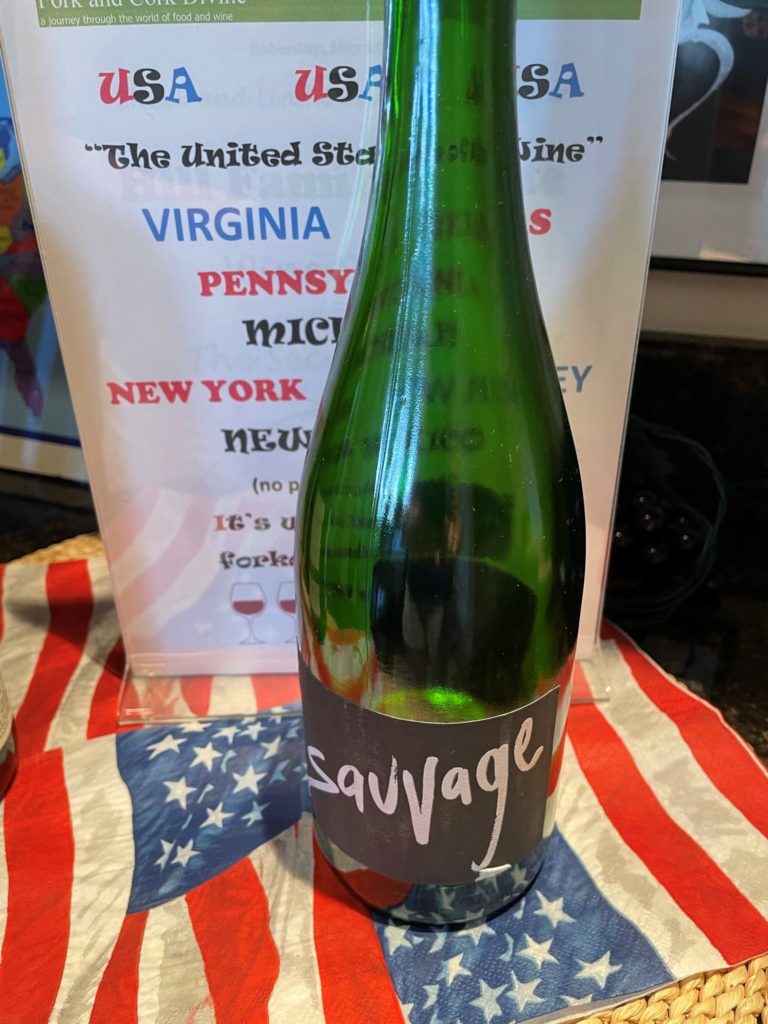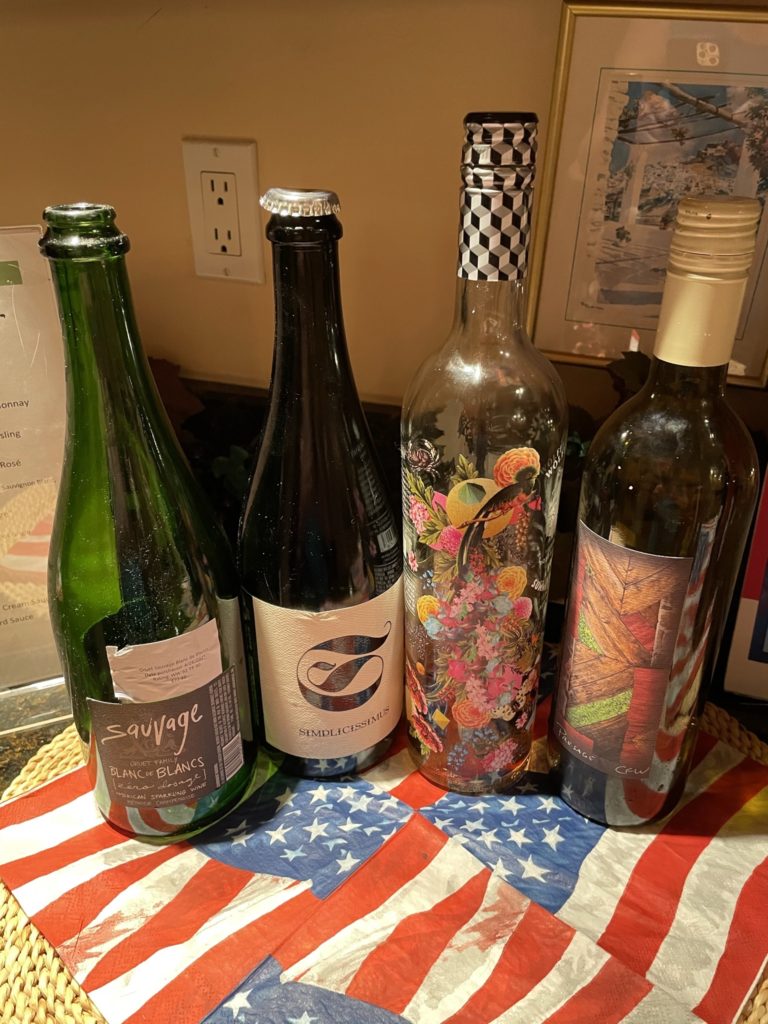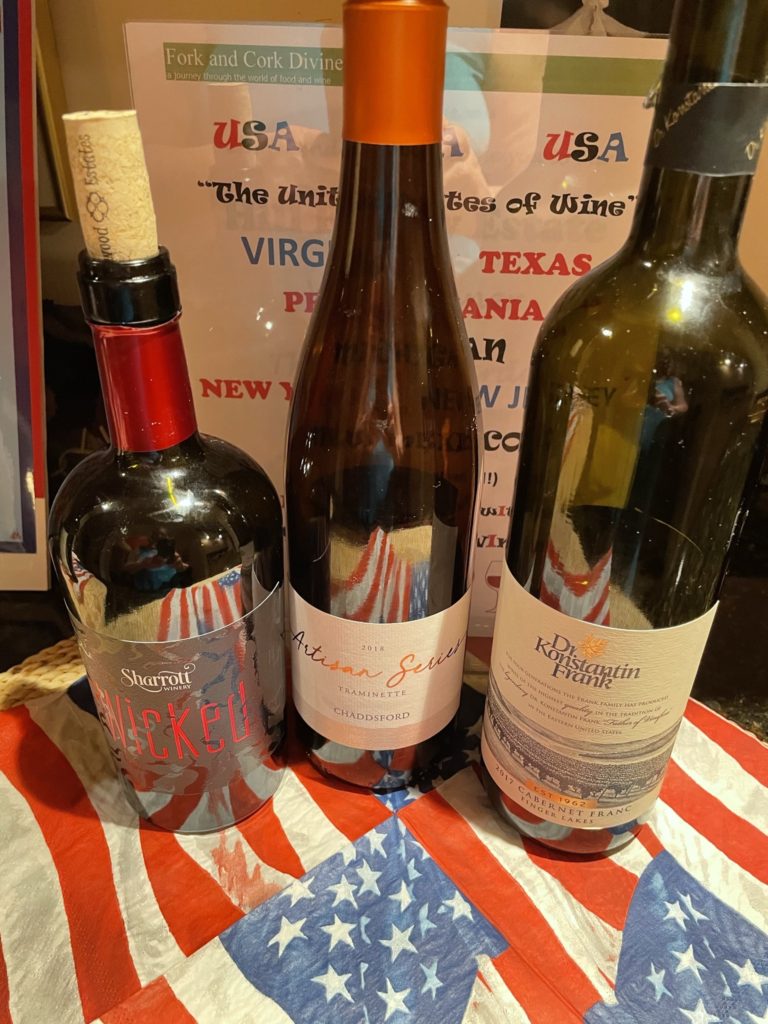It was all about the good old USA when a few serious lovers of wine and food gathered together for our most recent “wIne tIme” event. The theme was a celebration of wine “Made in the USA” but most importantly from states a little further down the list of major wine producers that we are so familiar with; i.e. California, Washington and Oregon. Our guests brought wine made in some other State that they knew we would all enjoy, and in many cases we were all tasting for the very first time. Of course, being the foodies that we are, there had to be a delicious culinary treat prepared and presented to go along with each special bottle of wine.
Once again our timing was impeccable! Just a few days after we decided to go with this theme, the May 2021 issue of “Food and Wine” magazine appeared in my mailbox. Their theme for the overall magazine was “The Escape Issue” and their article on Bottle Service was titled appropriately “The United States of Wine”: Five fantastic wine regions to discover – no passport required. So yes, I decided to piggyback with “Food and Wine” and go with “The United States of Wine” as our title, too. After all we thought of it first, right? And it’s really not anything too original. Now that we have that little tidbit of info out of the way, I would not be giving a good representation of forkandcorkdivine if I didn’t give you some United States wine information tidbits!
A quick overview of USA winemaking
There are over 11,000 wineries in these fifty United States of America, and wine is made in every one of them. The USA is not new to winemaking – wine has been made in America for over 300 years – but compared to Europe and parts of the world much further east like the country of Georgia, where wine can be traced back to 6000 BC, 300 years is just the blink of an eye. Now United States ranks fourth in the wine producing countries of the world, and three of the top wine producing companies in the world are from the United States.
We Americans should be pretty proud of our wines. After all, didn’t our California wine edge out the French wine in that very famous 1976 Judgment of Paris blind tasting wine event? Just 44 years later in 2020 California had over 4700 wineries (according to Statista.com) and produces 85-90% of our US wine. From the cult classic and unbelievably priced wines of Napa Valley like a bottle of 2018 Screaming Eagle that will set you back an average of $3300 on wine-searcher.com or probably $7500 or more for an older vintage (that is if you can find it and I may be off a few $1000s), or “just” some 2018 Schrader for an average $444 on wine-searcher down to a really great bottle of 2018 Cabernet Sauvignon from Joseph Phelps currently selling for $80 on wine.com. A bottle of 99 point Insignia is on sale for a paltry $250! Of course, there are many excellent bottles of wine available in every price range. The fun part is searching them out which we winelovers “love” to do!
Did we say there is wine made in every state? You bet! The very first AVA, or American Viticultural Area which is similar to the geographical wine classification system in Europe, was recognized in Augusta, Missouri in 1980. There were 252 approved AVAs in the US as of November 2020. The largest AVA is the “Upper Mississippi River Valley AVA” which crosses four states – Minnesota, Iowa, Wisconsin and Illinois – with a whopping big 19 million acres! And then there is the southernmost AVA, the “Texas Hill Country AVA” with over 14,000 square miles. Texas wine has been steadily gaining in recognition; Texas now ranks number four in number of US wineries by state (WinesVinesAnalytics.com). Here is one that may surprise you –Hawaii has an appellation – in fact one of the commercial wineries is the “Volcano Winery” near the summit of the Kilauea Volcano which should really not come as a surprise. Hawaiian winemakers primarily make fruit wines like a pineapple sparkling wine. The principal grape in Hawaii is the Symphony grape, a cross of the vinifera varieties Muscat of Alexandria and Grenache Gris, that makes white wine with a slight spiciness and aromas of citrus, apricot and peach.
It is hard to determine the actual number of wineries and AVAs in every state as one must search through many different sources of data; however according to the January 2021 listing from WinesVinesAnalytics.com who claims to be “the leading source for wine industry data”, California leads the way with almost 5,000 wineries, Oregon and Washington each have around 850, Texas has 470 and New York State has 433. Pennsylvania, Virginia and Ohio are all in the 300-400 range. Everybody else ranges somewhere between 0 and 300. So unless you are a stickler for those exact figures, these may be close enough for you.
According to a 2020 report from the Society of Wine Educators, there are currently 252 AVAs in 33 states with over half of them (141) being in California. American Viticultural Areas are approved by the TTB (Tax and Trade Bureau) of the Department of the Treasury.
Here are the newest established AVAs added in 2020:
11.18.2020 Tehachapi Mountain AVA in Kern County, California: 9.25.2020 Candy Mountain AVA in Washington State; 9.2.2020 Royal Slope AVA in Washington State bringing the state total to 15; 8.25.2020 Alisos Canyon AVA in Santa Barbara County, California and 6.3.2020 Tualatin Hills AVA and Laurelwood District AVA, both in Willamette Valley, Oregon (21 AVAs.)
“The United States of Wine” tour is now leaving the station……….
Sparkling, Rosé & White Wine Bar
NEW MEXICO Gruet NV “Sauvage” Blanc de Blanc Sparkling
Albuquerque, New Mexico
Gilbert Gruet was born in France in 1931 and aspired to produce quality Champagne, later creating the Union Vinicole des Coteaux de Bethon, a co-op in the village of Bethon in 1967. In 1983 the family was traveling in Southwestern United States and met a group of European winemakers near Truth or Consequence, NM, 170 miles south of Albuquerque. In 1984 their Champagne house, Gruet et Fils, began their American wine making adventure by planting an experimental vineyard of Pinot Noir and Chardonnay. In 1989 the first release of Gruet wine in the US made its debut. Since then they have won many awards and now have two tasting rooms, one in Albuquerque and one in Santa Fe. Gruet is known for their NV Brut sparkling, Blanc de Blanc, Blanc de Noirs, Brut Nature, Extended Tirage Rosé, Brut Sauvage, Sauvagé Rose, Demi-Sec and several still dry wines: Chenin Blanc and Pinot Meunier.
“Sauvage” is made from 100% Chardonnay grapes, is bone-dry and pale straw in color with a delicate but persistent mousse. Aromas of bright mineral and citrus notes are followed by green apple, lemon and grapefruit. The bright acidity makes it a perfect pairing for oysters, sushi and cream sauces.
MICHIGAN Mari Vineyards 2017 “Simplicissimus” Sparkling
Traverse City, Michigan
Mari Vineyards was born on Old Mission Peninsula in Traverse City, Michigan, the passion of Marty Lagina. Marty was born on the Upper Peninsula but has Italian roots. His background is in engineering and frequent adventures like treasure hunting on Oak Island. Marty, his son Alex and his brother Rick can be seen on the TV show, “The Curse of Oak Island”, as they attempt to use modern technology to hunt for treasure off the coast of Nova Scotia. Marty also uses his innovation to practice sustainability at Mari Vineyards from organics to composting to working with the “Bee and Butterfly Sanctuary” to replace lawns with sustainable cover crops in the form of pollinator habitats. He also has a wind energy company, Heritage Sustainable Energy. Mari Vineyard’s winemaker is Sean O’Keefe, the son of Ed O’Keefe, who founded Chateau Grand Traverse Winery in 1974. The history of Michigan grapes started back in the early 70s. Dr. Konstantin Frank was making a start on the Finger Lakes, and California consisted mainly of old Italian families who survived the Prohibition. This region in the Great Lakes is surrounded by water with a continental climate and there is nowhere exactly like it. Soils are predominantly sandy and drain well. Riesling, Chardonnay, Pinot Grigio are exceptional here. With Marty’s Northeastern Italian heritage, Alpine and Sub-Alpine grapes grow well here. Sean and his family have a great German influence, so between the two of them it is no wonder there are wines grown like Grüner Veltliner, Malvasia Bianca, Merlot, Refosco, Teroldego, Malbec and Nebbiolo.
The Simplicissimus Sparkling Riesling is clean and crisp with lemon curd fruitiness. It is made in a style somewhere between Pet-Nat (they did riddle the wine for clarity and to improve age ability) and traditional method (they don’t add sulfur, yeast or sugar). The natural grape sugar provides the sparkling character. Sean prefers to call it “method ancestral”.
“Simplicissimus” was a German Satirical magazine published from 1896-1967 that Sean really enjoys. The name originally stems from a book titled Simplicius Simplicissimus from 1669, fiction depicting the adventures of witty or roguish lower social class heroes in corrupt societies. It’s regarded as the first adventure novel in the German language and the first German novel masterpiece.
NEW YORK 2020 Wolffer Estate “Summer in a Bottle” Rosé
Long Island, New York
Wolffer Estate is located in the Hamptons on Long Island, New York. It was founded in 1988 by Christian Wolffer, a Hamburg, Germany-born international businessman, and owned and operated today by his children. The estate spans 170 acres plus they also manage 52 acres on the North Fork of Long Island, 200 acres in Mendoza, Argentina, 2.5 acres in Mallorca, Spain and manage 160 more acres in collaboration with North Fork growers. They have excellent maritime conditions (2.6 miles from the Atlantic Ocean) perfect for achieving the balance of ripeness and acidity that now defines Wolffer’s signature style: food friendly, elegant and built for longevity. They use sustainable farming and grow Merlot, Chardonnay, Cabernet Franc, Cabernet Sauvignon and small lots of Trebbiano, Pinot Noir and Vignole. Wolffer Estate is one of only three vineyards in the Hamptons appellation.
“Summer in a Bottle” is a blend of Merlot, Chardonnay, Cabernet Sauvignon, Cabernet Franc, Gewurztraminer, Sauvignon Blanc, Pinot Meunier and Pinot Blanc. It is bright shiny copper in color with aromas of pears and apples, a spiciness in the mouth and fine tannins. It is livened up by nice acidity and classic minerality with creamy yeast and delicate chalk notes on the finish. Very food friendly and a perfect summer wine. Serve it with smoked salmon, lobster, shrimp and soft cheeses; fish and pork.
PENNSYLVANIA 2018 Chaddsford Winery “Presage”
Chadds Ford, Pennsylvania
Chaddsford Winery is one of the oldest, largest and most acclaimed wineries in Pennsylvania producing more than 24,000 cases annually. You can find it in the Brandywine Valley of Chester County, southwest of Philadelphia. It was founded in 1982 by Eric Miller who sold the vineyards in 2012. The new owners moved the winery focus from dry wine to sweeter wines; however their dry 2017 Cabernet Franc was a finalist in the 2019 Pennsylvania Sommelier Judgement Day awards. The current goal is to produce “craft approachable, food-friendly wines for every palate”. The winemaking team celebrates the Mid-Atlantic Uplands microclimate at Chadds Ford and strives to make an evolving portfolio of dry, sweet and sparkling wines – something to satisfy everyone’s taste.
2018 marks just the second vintage of “Presage” which is a blend of five grapes. It showcases Vidal Blanc with it’s fruity characteristics as the main varietal. Other grapes are Seyval Blanc, Vignoles, Sauvignon Blanc, and Pinot Grigio. The wine spent 5 months in French oak which brings out the sweet baked apples, toasted almonds and ripe pears in it. Presage is a luscious, fruity and dry white wine that paired well with our seafood appetizer bar.
The Vidal Blanc grape is often shortened to Vidal and is a white hybrid resulting from the crossing of the Vitis vinifera grape Ugni Blanc (also known as Trebbiano Toscano) and another hybrid varietal, Rayon d’Or. Frenchman Jean Louis Vidal developed it in the 1930s hoping to use the grape in cognac production. When his grape ended up with some unexpected super powers — Its got a tough skin and is able to thrive in cold climates — it became tremendously popular in the American Northeast and Canadian wine regions.
Seafood Appetizer Bar
Smoked Salmon Roll Ups
Shrimp Cocktail with Two Sauces:
Traditional Cocktail Sauce Horseradish Sauce
Stone Crab Claws with Joe’s Famous Mustard Sauce
Baked Crab and Corn Poppers
Baked Oysters Melanie
Seafood almost always pairs well with sparkling, white and rose wine. And our seafood display was spectacular. You can’t go wrong with shrimp, stone crabs and oysters. Make a few delicious sauces and you will hear the praises from your guests. The salmon roll-ups looked beautiful and tasted even better and were so simple to make. And Mariann’s baked crab and corn poppers were definitely a hit!










Main Fare Buffet and Wines
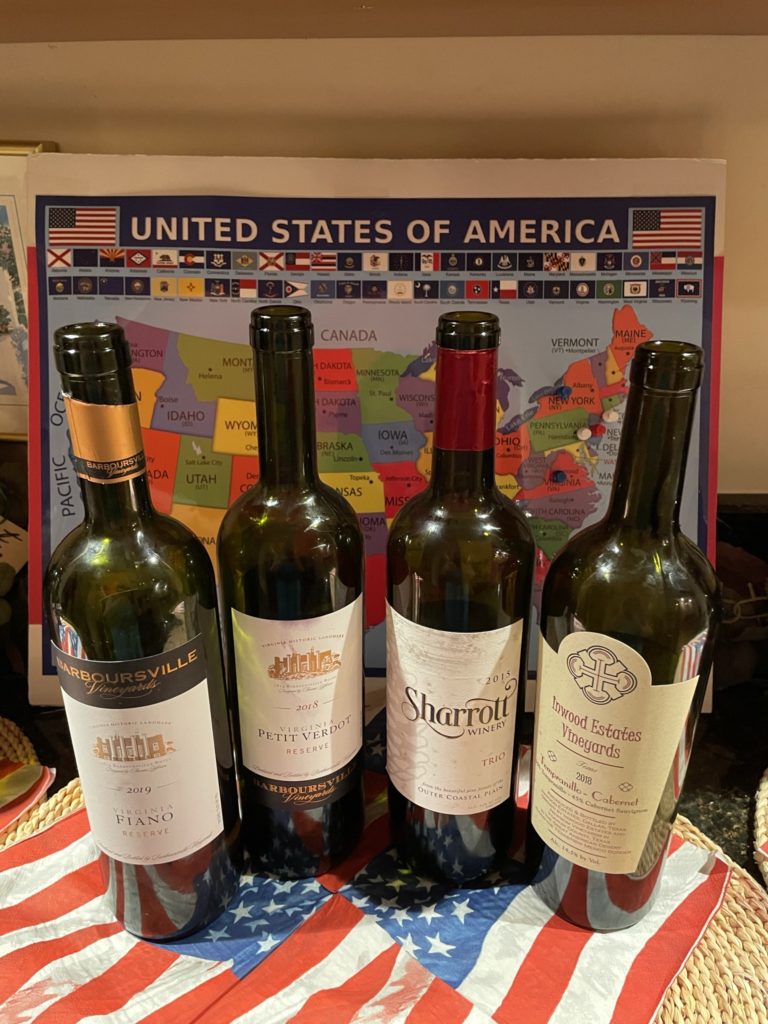
VIRGINIA 2019 Barboursville Vineyards Fiano Reserve
2018 Barboursville Petit Verdot Reserve, Barboursville, Virginia
Virgina Brunswick Stew with Spoonbread
Barboursville Vineyards is a winery located in central Virginia in the Virginia and Monticello AVAs. It was founded in 1976 by Gianni Zonin, an Italian winemaker from the Veneto whose Zonin family has been prominent in winemaking since 1821. The winery was built on the grounds of Barboursville, the home of the 19th Governor of Virginia, James Barbour. The home is based on an architectural design provided by Thomas Jefferson. Construction began in 1814 and was completed in 1821, just as Casa Vinicola Zonin was being founded in Palladio’s home province, the Veneto. This estate is the first producer in Virginian wine history to plant Vitis vinifera grape vines after failed attempts by Thomas Jefferson. Today Barboursville produces 35,000 cases of wine per year from predominantly Bordeaux grape varieties for red wines and Viognier, Chardonnay, Pinot Grigio and Sauvignon Blanc whites. Cabernet Franc, Cabernet Sauvignon, Merlot, Nebbiolo, Sangiovese, Barbera, Petit Verdot and Pinot Noir are all grown here. “Octagon”, one of the most renowned red wines in Virginia and the Barboursville flagship wine, is a Bordeaux-style wine mainly based on Merlot.
The Zonins opened a barrel aging room for Octagon in 2006, the year of the winery’s 30th anniversary. Chuck and I have visited Barboursville, and the Octagon barrel room is quite impressive. The estate itself is located on 900 acres of ground of sedimentary rock of volcanic origin, sandstone and conglomerates, with sloping exposures of even greater variety. The vineyards are exposed to temperate mid-Atlantic weather. You will also find an Inn and restaurant on the property.
Fiano was first produced on the East Coast here at Barboursville in 2015. Its an Italian white grape grown primarily in the Campania region of southern Italy and on the island of Sicily. It is particularly noted around Avellino especially the DOCG Fiano di Avellino. Outside of Italy, several Australian wine producers have begun to use the grape plus some winemakers in Argentina north of Mendoza. It’s grown here in central Virginia on the slopes of Goodlow Mountain. The 2019 Fiano Reserve consists of 93% Fiano and 7% Falanghina grapes that were fermented in stainless steel and aged on the lees for 7 months. It’s pale yellow in color with a green reflex, a very floral aroma, citrus with dried-lemon, peach, salt and stone character. It’s soft on the palate then increases in character and strength followed by a a long tasty dry fresh finish.
Petit Verdot is primarily used in classic Bordeaux blends as it adds tannin, color and flavor to the blend. It ripens fairly reliably here in the New World and is more frequently made into a single varietal wine. When young, its aromas have been compared to banana and pencil shavings. It also develops strong tones of violet and leather as it matures. It is grown at Barboursville mainly for use in the Octagon blend; however we got to enjoy it as a single varietal. The 2018 Petit Verdot Reserve was made from 100% Petit Verdot grapes, fermented in stainless steel, then aged for 12 months in French oak barriques. It has dense dark fruit color, rich, earthy intense flavors of black currant and licorice, followed by great palate length with fresh assertive tannins.
Both of these wines paired beautifully with Dave’s Virginia Brunswick Stew and Spoonbread. What a delicious treat!


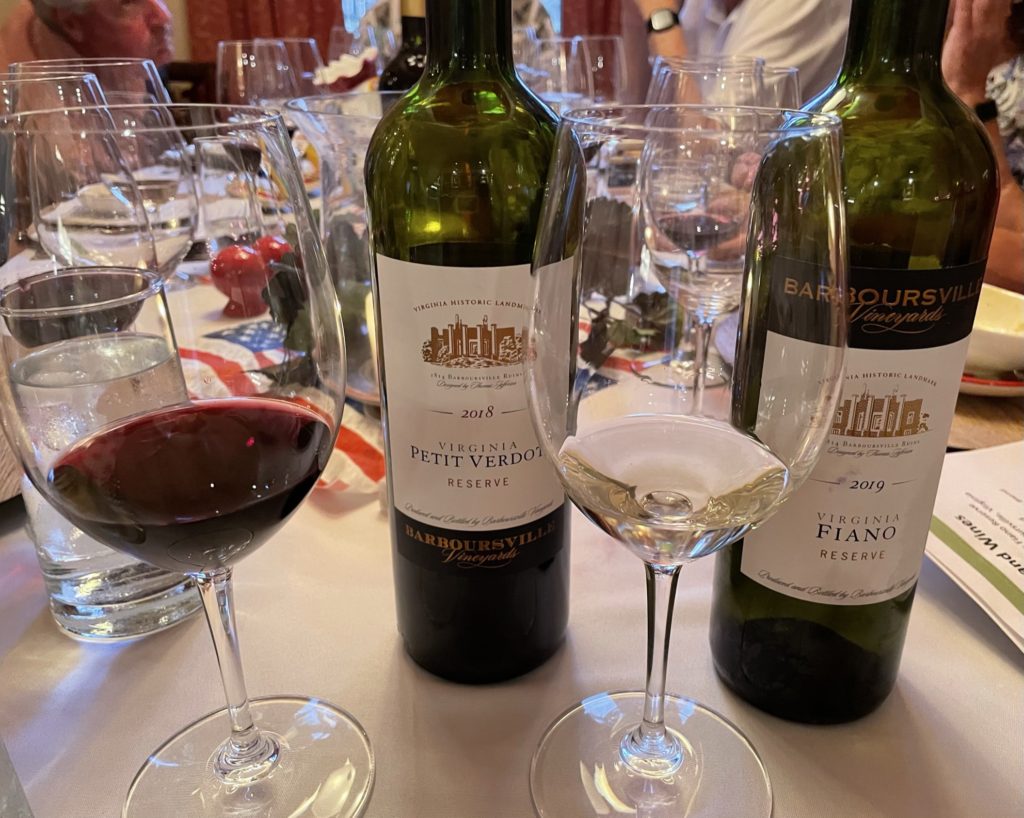
NEW JERSEY 2015 Sharrott Winery “Trio” Red Bordeaux Blend
Hammonton, New Jersey
The Sharrott Winery vineyards were first planted in 2005 on a former apple orchard in the Outer Coastal Plain AVA of Southern New Jersey and Camden County. The winery itself was founded by Larry Sharrott in 2006. The estate vineyard is on a flat plain with sandy soil full of quartz which encourages the summer rains to run off. Winters don’t reach freezing and Larry compares it somewhat to the Bordeaux area for climate and soil. Merlot is well-suited here with Cabernet requiring a bit more finesse. Larry’s initial desire was to make Chardonnay, Cabernet Sauvignon and Merlot their targeted wines, however he learned that you should probably produce what the customers want. And that was sweeter fruit wines! So they produced the popular blueberry wine plus cranberry and peach. Sooner or later, some customers gave those dry wines a try and actually liked them! Now sales have shifted from the “traditional” New Jersey wines to dry, varietal specific allowing them to make a “best in Class” at the Finger Lakes International Wine Competition for their second vintage of unoaked Chardonnay. Their 2015 “Trio” Red Bordeaux Blend won a Gold Medal at the Finger Lakes International Wine Competition. They now have a 34 acre property with about 25 acres planted in vines and are considering purchasing additional land. Who would ever have thought that New Jersey wines could compete with some of the world’s best? Larry Sharrott is leading the way!
The 2015 “Trio” is a red Bordeaux blend that is black garnet in color with complex aromas of fire-roasted beets, black cassis, lavender and tarragon with a medium full body and medium long bergamot and antique leather furniture finish.
As do most red Bordeaux-style wines, lamb is a great pairing. Jay’s lamb chops and Carolyn’s New Jersey”ish’ blueberry mint sauce really made that Trio shine. After all New Jersey is known for it’s blueberries……..and tomatoes…….and maybe now for it’s wine!
Lamb Chops with Blueberry Mint Sauce

TEXAS 2018 Inwood Estates Tempranillo-Cabernet
Texas High Plains, Fredericksburg, Texas
Dan Gatlin grew up in the retail beverage trade as his family owned and operated the Hasty chain of wine, spirits and convenience stores in Dallas, Texas. Dan built his wine skills as a buyer and eventually VP of the company. When his parents died and Hasty was sold, he turned his interest to vineyard research. He had close ties with the California wine industry and began to research whether Texas held any possibilities for wine production by establishing one of the first vineyards in the state, in 1981. This first vineyard proved to be an invaluable source of information. He discovered that the terroir here was best suited for varieties found in southern Europe especially the Iberian peninsula and southern Italy. In 1997 the Gatlins bought in a then undervalued part of Dallas where they remodeled the house as their residence and planted a 245-vine “urban” vineyard. They did produce some Palomino-Chardonnay with a yield of less than 50 gallons per year. Palomino is usually used to produce sherry in Spain. After a total of 5 other vineyards, Dan put in a block of Tempranillo in Yoakum County, Newsom Vineyards. This vineyard is now the producer of the Tempranillo and Cabernet that go into their Inwood Estates flagship wine. The winery was built in j2005. The 2003 Temp-Cab and 2005 Palo-Chard were released August 1, 2006 to a great reception of restaurant customers in Texas’ four largest cities.
Texas is widely regarded as the preferred home for producing America’s finest versions of Spain’s famed Tempranillo wines. Inwood produces a blend of Tempranillo and Cabernet in the classic tradition of northern Spanish river valleys, as well as the newer modern varietal Tempranillos. This one is full-bodied and inky – 55% Temp and 45% Cab – using grapes grown exclusively in the Texas High Plains, just a few miles from the Texas-New Mexico border. It exhibits sumptuous red fruit flavors of cherry, raspberry and strawberry from the Temp and darker flavors of blackberry, black currant and cassis from the Cab. Chocolate, nutty finish lingers from aging in French Oak barrels.
Texas High Plains AVA is the second largest in Texas with 422 square miles and 270,000 acres. There are at least 6 wineries within the AVA although many wineries outside of the AVA source grapes from the high plains. When I think of food to pair with Texas wine, beef and Tex-Mex comes first to mind. Chuck being a “seasoned” steak cooker on our indoor stovetop grill pan, a rib-eye steak went immediately on the menu. Complement it with some beautiful mushrooms, a BBQish sauce for the meat (that is if you don’t have to be a purist with no sauce!), well seasoned pinto beans cooked all day in a slow cooker with jalapeno peppers, and some really tasty eggy mustardy potato salad. All in all it’s a marriage made in heaven with that bottle of tempranillo-cab.
Rib-eye Steak “Texas-style” a la Chuck with Mushrooms
Texas Sauce
Tex-Mex Pinto Beans and Texas-style Potato Salad






Dessert Table and Wines
NEW JERSEY Sharrott Winery “Wicked” Port-style Wine
Chocolate Blueberry Brownies
Sharrott NV Wicked is a port-style wine made from Chambourcin with aromas of roasted nuts, dark chocolate shavings, lacquer and salted molasses topping. You will also taste flavors of black pepper and raspberry liqueur all making it a perfect pairing for Carolyn’s decadent chocolate blueberry brownies. It/s a balanced and peppery dessert wine that will taste wonderful with a plate of cookies, a crème brulee and mixed berries.
PENNSYLVANIA 2018 Chaddsford Winery Artisan Series Traminette
Finger Lakes, NY
Pennsylvania Gooey Butter Cake
The 2019 Chaddsford Artisan Series Traminette is a soft and sweet wine with notes of lychee, honey, sweet peaches, flowers and candied mango making it a good choice for Mariann’s authentic Pennsylvania Gooey Butter Cake. The 100% traminette grapes were harvested in the New York Finger Lakes area, and the 153 cases were finished in stainless steel. The next time I ever see this ooey gooey sinful cake, I’ll race you to the table for it!



Cheese Board
NEW YORK 2016 Dr. Konstantin Frank Cabernet Franc
Finger Lakes, NY
Dr. Frank ignited the “Viniferia Revolution” a movement that forever changed the course of wine growing in the Finger Lakes and the US. His vision, knowledge and determination are credited with elevating the NY wine industry from happy mediocrity to a level that today commands world attention. Dr. Frank’s Wine Cellars includes a winemaking team from CA, Australia, France and Germany. Their focus is on world class wines with a tradition of excellence. Dr. Frank emigrated to NY in 1951 at the age of 52 with a PhD in Viticulture from Odessa, Ukraine and decades of experience in vineyard management. He also survived two world wars and the Russian Revolution. He knew the climate and soil was right for growing high quality cold weather grapes, and he pushed forward despite opposition to plant the first Riesling, Chardonnay and Pinot Noir vines in the Finger Lakes revolutionizing the Eastern US.
The 2016 is a light-bodied Cab Franc that offers tones of spiced currant and cranberry on the nose and palate with a framing of green herbs. It has a juicy acidity and fine-grained tannins that meld with the tart red fruit flavors. I selected cheeses that were said to pair well with the Cab Franc, and so they did. You can’t miss with a good and simple cheese board.
Camembert, Cheddar, Goat and Swiss







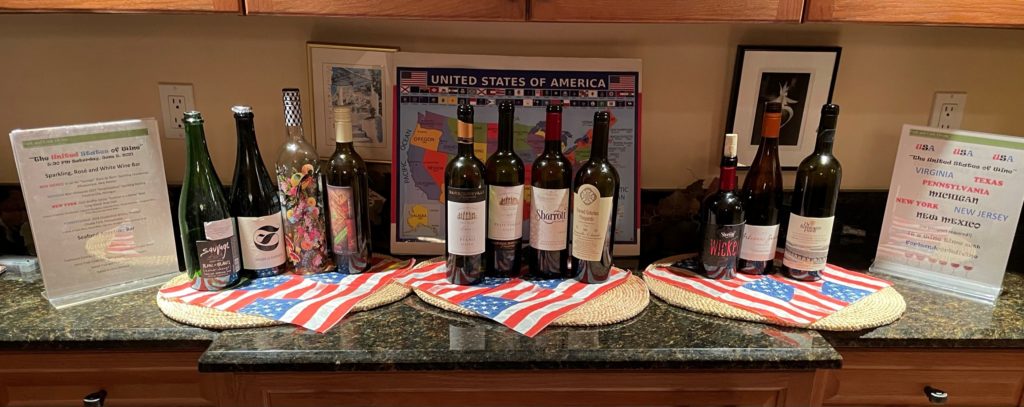
WHAT A PERFECT SALUTE TO FLAG DAY JUNE 14, 2021
LFRakos@gmail.com
forkandcorkdivine.com
6.14.2021

